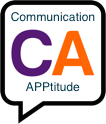Why?
A common question asked is, "Why does my child stutter?" The answer: no one knows why. The book points out that we usually want to know why something happens so we can eliminate the cause and stop the stuttering. Unfortunately, this is not possible. Some think imitating stutterers will cause stuttering. This is a myth - most stutterers begin stuttering on their own without having heard someone else stutter. There are genetic dispositions to stuttering. You may know of another family member who stutters. Most importantly,
Parents should not blame themselves for their child's stuttering.The way you raise your child has little to do with why your child stutterers. But, there are things you can do to help your child.
Suggestions for Parents
You can change some of the ways you do things at home to help your child. Too often family members try to finish her sentences, interrupt while she is talking, or encourage a fast rate of speech. To help your child, consider these suggestions to parents from Dr. Richard Curlee:
1) Accept your child. Find ways to show your child that you love and value her, and you enjoy spending time with her.
2) Listen patiently. Respond to the "message" rather than how it is relayed.
3) Avoid filling in or speaking your child's thoughts and ideas. Her thoughts and ideas should be her own.
4) Maintain natural eye contact. Don't look away or stare at your child while she is talking.
5) Don't interrupt - allow your child to complete what she is saying.
6) Spend 5 minutes a day devoted to listening and talking with your child in a relaxed manner.
7) After your child speaks use some of the same words she did, but in a relaxed way. By doing this you will be modeling a good speech pattern.
8) Pause at least one second before reponding to your child. Don't hurry the response.
You should know...
- More boys than girls stutter (4:1)
- 3 million Americans stutter and 68 million people world-wide stutter
- 5% of all children go through a period of stuttering that lasts 6 months
- 3/4 of children who stutter will recover by late childhood
- 1% of children who begin stuttering, continue to stutter
- If your child stutters, see a speech-language pathologist who specializes in stuttering right away.
- Early intervention is the key to treating children who stutter
- There are no miracle cures for stuttering, but progress can be made.
For more information, visit www.stutteringhelp.org.




